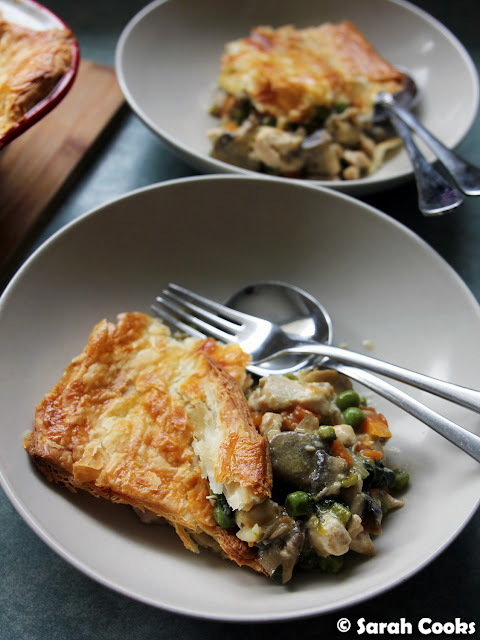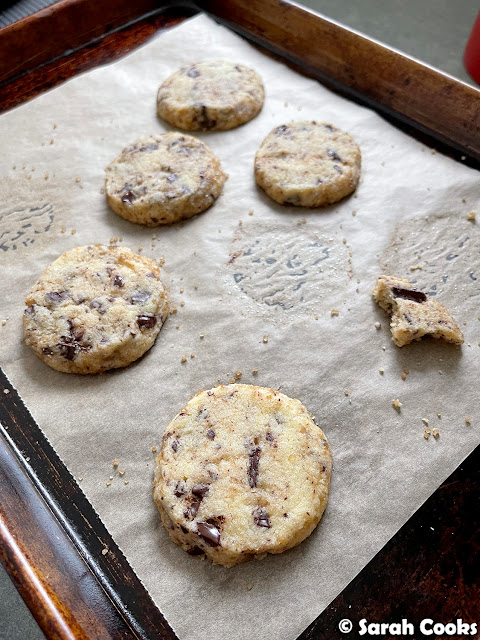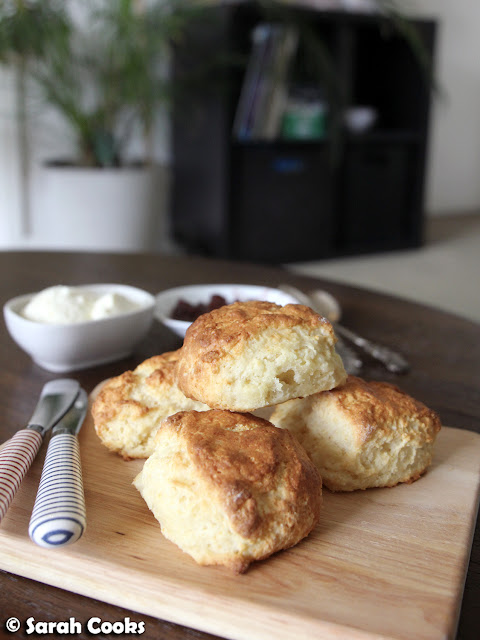The Best Roast Pork Shoulder and my tips for perfect crackling...
10/29/2012 06:34:00 PM |
| Roast pork shoulder |
The centrepiece of my most recent PORKTOBERFEST lunch was a resplendent roast pork shoulder, all juicy and tender with a crisp layer of crackling on top. Normally when I cook roast pork, I simply point you in the direction of the recipe I used - but in this instance I made the recipe up myself, so I'm pleased to be sharing it with you here!
I really only decided the day before the party what the central porcine item would be - I had thought of doing a very slow-roasted rolled pork shoulder, to be torn apart with forks into succulent little morsels like pulled pork - but in the end, I thought a single piece of meat, to be cut into thick slabs, would be more celebratory. And crucially, my local butcher only had unrolled, de-boned pork shoulder! So I did slow roast it at a low temperature, but just not quite as long as I'd do it for melting shreds of pulled pork. (For pulled pork, you could go anywhere from 12 to 24 hours!) I roasted this two kilogram piece of pork at 120C for six hours, with a final 30 minute hot blast for crackling. (And yes, this means I set my alarm for 6AM to get this pork started, and then toddled off back to bed).
And because I am the queen of crackling (a title I have unashamedly bestowed upon myself!), let me share with you some tips for getting the perfect crackling.
I have mentioned this many times before, but it bears repeating: to get good crackling, you need the rind to be dry, dry, dry! Buy it the night before, remove any plastic and let it dry overnight, uncovered, in the fridge.
(I've seen some recipes for Chinese crisp roast pork that say to pour boiling water over the rind before roasting it, but I've never figured out how that wouldn't dampen and thus kill your crackling. I wouldn't personally recommend that method).
While the oven is preheating, I rub the rind with a little olive oil (again, to aid in the quest for crackling!) and sprinkle it generously with sea salt, fennel seeds and caraway seeds. The salt draws the moisture out of the rind, enabling crisp crackling and of course tastes good. I love the aniseedy aroma of the fennel and caraway seeds against the rich pork, but you can use any other flavourings you like (or none at all - plain salt is still good!).
 |
| Pork, almost ready for the oven |
 |
| Roast pork |
Conversely, if your crackling-creating hot-blast is too hot, you'll get gigantic, scary-looking yellow bubbles which, again, are chewy and unpleasant. With my oven, I find that 220C-230C works best, but as all ovens differ you'll have to get to know your own. Trust your eyes and remember that you want an even layer of fine bubbles.
I think you could make a sauce out of the pan juices (indeed, all the connective tissue in the pork shoulder will produce a particularly nice, jellied sauce), but there really is too much fat floating the pan around to be able to do this easily. (At this particular lunch, you'll remember we also had a bunch of other dishes to prepare, so I didn't have time to be carefully straining and spooning off the pan juices).
And here it is!
 |
| Roast pork shoulder |
It looks quite a bit like pork belly when roasted, and being boneless, was incredible easy to carve. Controversial of me to say it I know, when Melbourne seems to be in the grip of Pork Belly Fever, but I like roast pork shoulder even better. You get the crunchy carapace of crackling, you get the juicy and tender meat, but you get a much more satisfying meat-to-fat ratio, without any big mouthfuls of wibbly wobbly fat that you can get with pork belly. The method is ridiculously easy too. If you're a pork lover like me, hop to it!
Perfect Roast Pork Shoulder
An original recipe by Sarah Cooks
Ingredients
1 x 2kg boneless shoulder of pork, in one flat piece with the rind on
Olive oil
1/2 teaspoon each fennel and caraway seeds, or to taste
Salt
1 glass dry white wine
Method
Remove any wrapping from the pork and lay it out flat in a tray, skin side up. Allow to dry, uncovered, in the fridge overnight.
7 hours before you plan to eat, take the pork out of the fridge to allow it come to room temperature, and preheat the oven to 120C. Drizzle the olive oil over the pork rind, rubbing it in with your fingers (or a pastry brush). Sprinkle over a generous amount of sea salt, followed by the fennel and caraway seeds. Pour the wine around the pork, being careful not to get any of the liquid onto the rind. Cover the tray with foil, and place into the oven. Roast for 6 hours.
Remove the foil, and increase the oven to 230C. Roast for 20-30 minutes, or until the rind has turned into glorious, glorious crackling.
Remove from the oven and allow to rest for 30 minutes. Carve into thick slabs to serve.
Serves 6 lucky people












20 comments
Sarah I absolutely love this post!! I've been having trouble the past few times to get the right crackling, I seem to be getting very rubbery, chewy, sticky bits and totally aggravated me to the bone. (Note: Do NOT stand in the way of a Chinese and their crispy skin pork). I left it uncovered in the fridge too but still turned out like that. I think it's cause I didn't use oil. This really answers a lot of my questions I'm going to give it a go with your method now. Have been so discouraged to remake this after 2 consecutive failed attempts but I think it's time to change that. And omg you're not wrong about pork shoulder. It really is much better and I like the meat better too with less fats in between, but just at the rind. YUMMEHHHH
ReplyDeleteSarah, the boiling water method scalds the skin, causing the cuts of the scoring it open right up. That way you can get salt in/under the skin.
ReplyDeleteYou have to be prepared to dry it right out with paper towel. Although i don't see why you couldn't do it the night before and put it in the fridge like you do.
Another tip, never salt too early, only do it at the last second before it goes in the oven.
omg now that's sex on a chopping board! lol. hubba hubba!
ReplyDeleteThere was a Poctoberfest and I wasn't invited?? HmMmmMMmm LADY! hahahah... this looks amazing... We just cheat and grill it :P
ReplyDeleteThis looks lovely. I've never tried roasting a shoulder but I'm tempted to try after reading this.
ReplyDeleteRob
Pork shoulder looks so amazing. Taking notes of the tips.
ReplyDeleteYou ARE the Queen of Crackling. You need new business cards. :)
ReplyDeleteI pour boiling water over a piece of pork every time I roast it and I get perfect crackling each time. It allows the salt to get in and aids the crackling process like nothing else! But as Andrew Barker stated earlier - you must dry the rind before salting. Try it - it works beautifully
ReplyDeleteRead all your advice and like you I find the high temperature at the finish of the slow cooking always works best for me. This time however I was going to try the Coco Cola Glaze so the Crackling had to be first as the shoulder must be dry. Not sure if my old St George oven was up to temperature at the start so set it at 500 F for 30 mins and then 275 F for the slow cooking. Poured Coco Cola liberally over the whole shoulder and basted it several times thereafter. Would have liked to have basted it much more but I had to go out several times. At the finish of the slow cooking I gave it another short blast of heat 10/15 mins to finish the crackling. The crackling was perfect, the meat was juicy and tender, and the Coca Cola Glaze was a magnificent Red Colour and if I'd had the time to baste more often would have been even better.With the apple sauce i used Granny Smith Apples, cooked in pure Apple Juice and Apple Cider Vinegar and Cinnamon Sugar. Thank you so much for your advice Sarah and I would highly recommend the Coco Cola Glaze
ReplyDeleteHi Sarah,can you kindly adviae why need to cover the pork with foil when baking at low temp. TIA.
ReplyDeleteHi Josephine - the foil prevents the pork from drying out. A friend of mine recently made this recipe and forgot the foil, and the meat dried out completely. The crackling was still good though!
DeleteDo you cover the pork to rest it?
ReplyDeleteUsually I cover it loosely in foil. But it doesn't cool down too much if you're only resting for 30 minutes.
DeleteYUUUUUMMMM!!!! Made this for first family Xmas dinner a few nights ago - it was perfect!!! Couldn't believe the crackle crackled just as described!! I always have trouble getting this to happen. I used a little white wine and almost a glass full of apple and elderflower juice in bottom of pan. This recipe is a cracker and a keeper. Thanks for sharing it Sarah!
ReplyDeleteHooray! So glad you have success with the recipe! :) :)
DeleteThis was delicious, the meat was so tender & flavoursome & the crackling was perfect! Will definitely be making this again. The family loved it. I didn't think the crackling would work cooking it at the end but it was absolutely fabulous. Thanks for the recipe ��
ReplyDeleteYay!! So glad it worked for you! :) xox
DeleteThe boiling water method works but not as necessarily described here.
ReplyDelete24 hours before cooking I score the skin and pour boiling water over it to open up the scoring (and thus allowing the pork fat out). I then thoroughly dry it, cover liberally with salt and leave it in the fridge uncovered for up to 24 hours. The low humidity of the fridge removes moisture. The salt does the same so when you get it out of the fridge the next day you can feel how dry the skin is.
Oil is not necessary. The scoring allows the fat from the pork to do the basting for you. Oiling the pork hinders this process.
Variable temperatures are not necessary either. The scoring process will allow the crackling to puff up beautifully.
One thought about long cooking. Whenever I do a pork belly, I run my convection oven at 225 degrees. You get great crackling and moist pork because it only takes an hour. Something similar might work for an unrolled shoulder - I'll try it out.
Hi Unknown,
DeleteI love the detailed tips!! I will give the boiling water method a go in the future.
Cheers,
Sarah
I would like to do this for a large crowd maybe 50 not sure how to go about that?
ReplyDelete